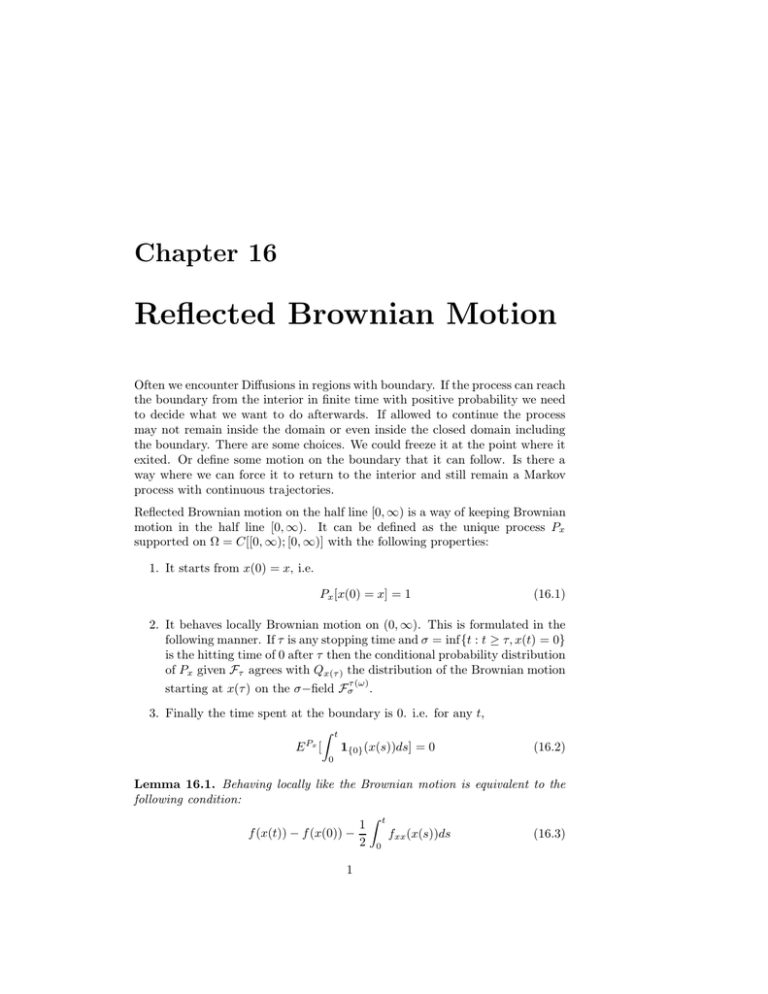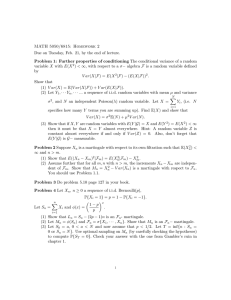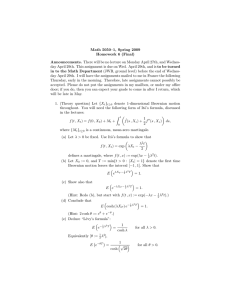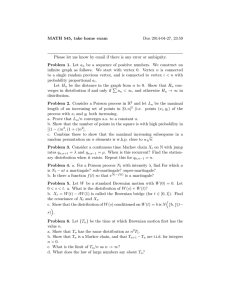Reflected Brownian Motion Chapter 16
advertisement

Chapter 16
Reflected Brownian Motion
Often we encounter Diffusions in regions with boundary. If the process can reach
the boundary from the interior in finite time with positive probability we need
to decide what we want to do afterwards. If allowed to continue the process
may not remain inside the domain or even inside the closed domain including
the boundary. There are some choices. We could freeze it at the point where it
exited. Or define some motion on the boundary that it can follow. Is there a
way where we can force it to return to the interior and still remain a Markov
process with continuous trajectories.
Reflected Brownian motion on the half line [0, ∞) is a way of keeping Brownian
motion in the half line [0, ∞). It can be defined as the unique process Px
supported on Ω = C[[0, ∞); [0, ∞)] with the following properties:
1. It starts from x(0) = x, i.e.
Px [x(0) = x] = 1
(16.1)
2. It behaves locally Brownian motion on (0, ∞). This is formulated in the
following manner. If τ is any stopping time and σ = inf{t : t ≥ τ, x(t) = 0}
is the hitting time of 0 after τ then the conditional probability distribution
of Px given Fτ agrees with Qx(τ ) the distribution of the Brownian motion
τ (ω)
starting at x(τ ) on the σ−field Fσ .
3. Finally the time spent at the boundary is 0. i.e. for any t,
Z t
1{0} (x(s))ds] = 0
E Px [
(16.2)
0
Lemma 16.1. Behaving locally like the Brownian motion is equivalent to the
following condition:
Z
1 t
f (x(t)) − f (x(0)) −
fxx (x(s))ds
(16.3)
2 0
1
2
CHAPTER 16. REFLECTED BROWNIAN MOTION
is a martingale for any bounded smooth function f that is a constant (which can
be taken to be 0 with out loss of generality) in some neighborhood of 0.
Proof. The equivalence is easy to establish. Let us take ǫ > 0 and consider
the exit time τǫ from (ǫ, ∞). Any smooth function on [ǫ, ∞) can be extended
to [0, ∞) in such a way that it has compact support in (0, ∞). Therefore the
martingale property (16.3) holds for arbitrary smooth bounded f until τǫ . Hence
Px agrees with Qx on Fτǫ . But ǫ > 0 is arbitrary and we can let it go to 0.
Fτǫ ↑ Fτ as ǫ → 0. In the other direction if f is supported on [a, ∞) we
can consider the sequence of stopping times defined successively, starting from
τ0 = 0 and for j ≥ 0,
τ2j+1 = inf{t : t ≥ τ2j , x(t) = 0}
and for j ≥ 1,
τ2j = inf{t : t ≥ τ2j−1 , x(t) = a}
Clearly
Z(t) = f (x(t)) − f (x(0)) −
1
2
Z
t
fxx (x(s))ds
0
is a martingale in [τ2j , τ2j+1 ] and is constant in [τ2j−1 , τ2j ] when x(t) ∈ [0, a].
It is now easy to verify that Z(t) is a martingale. Just write for s < t,
X
Z(t) − Z(s) =
[Z((τj+1 ∨ s) ∧ t) − Z((τj ∨ s) ∧ t)]
j≥0
Theorem 16.2. There is a unique Px satisfying (16.1), (16.2) and (16.3). It
can also be characterized by replacing (16.2) and (16.3) by the following. f is a
smooth bounded function satisfying f ′ (0) ≥ 0, then
Z
1 t
fxx (x(s))ds
(16.4)
Zf (t) = f (x(t)) − f (x(0)) −
2 0
is a sub-martingale with respect to (Ω, Ft0 , Px ). In particular if f ′ (0) = 0, Zf (t)
is a martingale. If β(t) is the ordinary Brownian motion starting from x, then
Px is the distribution of x(t) = |β(t)| and is a Markov process with transition
probability density,
for t > 0, x, y ≥ 0.
y+x)2 1 (y−x)2
p(t, x, y) = √
e 2t + e 2t
2πt
Remark 16.1. In both (16.3) and (16.4) the condition that f is bounded can be
dropped and replaced by f having polynomial growth. If f is x2n for large x,
then fxx is cn x2n−2 . If n = 1
Z t
E[[x(t)]2 ] = E[[x(0)]2 ] +
1 ds
0
3
This is easily justified by standard methods of approximating x2 by bounded
functions below it. By induction on n, one can show in a similar fashion that
Z t
2n
2n
E[[x(t)] ] = E[[x(0)] ] + n(2n − 1)
[x(s)]2n−2 ds
0
2n
and deduce bounds of the form E [x(t)]
≤ Cn [x2n + tn ] for all n. Then the
martingale property will extend to smooth functions with polynomial growth.
Proof. First let us establish the equivalence between (16.2)-(16.3) and (16.4).
Given a function f (x) with f ′ (0) = 0, we can approximate it with functions
that are constant near 0. f (n) (x) = f (0) for 0 ≤ x ≤ n1 and f (n) (x) = f (x − n1 ).
It is piecewise smooth, with matching first derivatives. Therefore it is easy to
check that
Z t
(n)
fxx
(x(s))ds
f (n) (x(t)) − f (n) (x(0)) −
0
(n)
(n)
is a Martingale. Let n → ∞, then f
→ f and fxx → fxx except at 0. But
(n)
fxx is uniformly bounded and because of (16.2) we obtain (16.4) for functions
with f ′ (0) = 0. Conversely if Z(t) is a martingale when f ′ (0) = 0, we can then
show that (16.2) holds. Consider the function
(
x2
if x ≤ ǫ
fǫ (x) =
(16.5)
2ǫx − ǫ2 if x ≥ ǫ
It is piecewise smooth, with matching first derivatives. Therefore
E[fǫ (x(t))] − fǫ (x) =
Z t
Z t
1
E[
fǫ′′ (x(s))ds] = E[
1[0,ǫ] (x(s))ds]
2
0
0
Since fǫ (x) ≤ 2ǫx it follows that
Z t
lim E[
1[0,ǫ] (x(s))ds] = 0
ǫ→0
0
proving (16.2).
To prove the sub-martingale property, let φ(x) be a smooth, bounded function that is identically equal to x in some interval [0, δ]. Then g(x) = f (x) −
f ′ (0)φ(x) satisfies g ′ (0) = 0 and therefore Zg is a martingale. It is then enough
to prove that Zφ (t) is sub-martingale. We repeat an argument used earlier in
the proof of Lemma 16.1 of writing
X
Zφ (t) =
[Zφ (τj+1 ∧ t) − Zφ (τj ∧ t)]
j
with a = δ. The terms with even j are martingales and as for terms with odd
j, φ(x(τj+1 ∧ t)) − φ(x(τj ∧ t)) ≥ 0. An easy calculation now shows that
E Px [Zφ (t) − Zφ (s)|Fs ] ≥ 0
4
CHAPTER 16. REFLECTED BROWNIAN MOTION
Finally we will identify any Px satisfying (16.1), (16.2) and (16.3) or (16.4), has
the distribution of x(t) = |β(t)| starting from β(0 + x. p(t, x, y) is clearly the
transition probability of |β(t)| which is Markov because Brownian motion has
the x → −x symmetry. The function
Z
u(t, x) = q(t, x, y)f (y)dy
satisfies
1
uxx ; u(0, x) = f (x), ux (t, 0) = 0
2
Just as in the case of diffusions with out boundary, if
Z
1 t
fxx (x(s))ds
f (x(t)) − f (x(0)) −
2 0
ut =
is a martingale for all smooth f satisfying f ′ (0) = 0, then it follows that for all
smooth functions v = v(s, x) satisfying vx (s, 0) = 0 for all s,
Z t
1
v(t, x(t)) − v(0, x(0)) −
[vs (s, x(s)) + vxx (0, x(s))]ds
2
0
is a martingale. Therefore u(T −t, x(t)) is a martingale under Px and E Px [f (x(T )] =
u(T, x). This identifies the marginal distributions of Px as that of |β(·). Regular
conditioning argument allows us to complete the identification.
The reflected Brownian motion can be defined in terms of the ordinary Brownian motion β(t) as a solution of the equation x(t) ≥ 0
x(t) = x + β(t) + A(t)
where A(t) is continuous and increasing, but is allowed to increase only when
x(s) = 0, i.e
Z
dA(s) = 0
{s:x(s)>0}
Such a solution is unique. If xi (t); i = 1, 2 are two solutions
d[x1 (t) − x2 (t)]2 = 2(x1 (t) − x2 (t))d(A1 (t) − A2 (t))
= −2x1 (t)dA2 (t) − 2x2 (t)dA1 (t) ≤ 0
But x1 (0) = x2 (0). Implies x1 (t) ≡ x2 (t) for all t.
Existence is easy.
x(t) = x + β(t) − inf [(x + β(s))− ]
0≤s≤t
is clearly non negative. A(t) = − inf 0≤s≤t [(x + β(s))− ] is increasing and does so
only when [x + β(t)]− = −A(t), i.e. x(t) = 0. The reflected Brownian motion
comes with a representation
x(t) = β(t) + A(t)
5
where A(t) is a local time at 0, almost surely continuous in t, acting as an
infinitely strong drift when x(t) = 0 which is a set of times of Lebesgue measure
0. This leads to an Ito’s formula of the form
1
du(t, x(t)) = ut (t, x(t))dt + ux (t, (x(t))dx(t) + uxx (t, (x(t))dt
2
1
= ut (t, x(t))dt + ux (t, (x(t))dβ(t) + ux (t, 0)dA(t) + uxx (t, (x(t))dt
2
which is a way of seeing the effect of the boundary condition satisfied by u.
There is a way of slowing down the process at the boundary. Let
σ(s) = ρA(s) + s
Define increasing family of stopping times {τt } by
σ(τt ) = t; τσ(s) = s
which has a unique solution which is strictly increasing and continuous in t.
Since ds and dA(s) are orthogonal (A(s) increases only when x(s) = 0 which is
a set of 0 Lebesgue measure), we have
dA(s) = ρ−1 1{0} (x(s))dσ(s)
and
ds = 1{(0,∞)} (x(s))dσ(s)
We can now define a new process
y(t) = x(τt )
We will identify the martingales that go with this process. By Doob’s optional
stopping theorem,
Z
1 τt ′′
Zf (t) = f (x(τt )) − f (x(0)) −
f (x(s))ds − f ′ (0)A(τt )
2 0
Z
1 τt ′′
f (x(s))1(0,∞) (x(s))dσ(s)
= f (x(τt )) − f (x(0)) −
2
Z τt 0
1{0} (x(s))dσ(s)
− ρ−1 f ′ (0)
0
Z t
1
= f (y(t)) − f (y(0)) −
f ′′ (y(s))1(0,∞) (y(s))ds
2 0
Z t
1{0} (y(s))ds
− ρ−1 f ′ (0)
0
is a martingale. The new process is then a Markov process with generator
(
1 ′′
f (x)
if x > 0
(Lf )(x) = 2−1 ′
ρ f (0) if x = 0
6
CHAPTER 16. REFLECTED BROWNIAN MOTION
We can calculate the Laplace transform in t of the probability Px [x(t) = 0].
This requires us to solve the resolvent equation, denoting ρ−1 by γ
1
λψ(x) − ψ ′′ (x) = 0, λψ − γψ ′ (0) = 1
2
which can be done explicitly to give
Z ∞
√
1
√ e− 2λ x
e−λ t p(t, x, {0})dt =
λ + γ 2λ
0
In particular p(t, 0, {0}) → 1 as t → 0. But 1 − p(t, 0, {0}) does not go to 0
linearly in t. {0} is an instantaneous state. As γ → ∞ this becomes the reflected
process and as γ → 0 the absorbed process. For the characterization of these
processes {Pγ,x } through martingales we have the following theorem.
Theorem 16.3. The process {Pγ,x } is characterized uniquely as the process
with respect to which
Z t
1
u(t, x(t)) − u(0, x(0)) −
[us (s, x(s)) + uxx (s, x(s))]1(0,∞) (x(s))ds (16.6)
2
0
is a sub-martingale provided (ut + γux )(t, 0) ≥ 0 for all t.
Proof. First let us prove that for any smooth bounded u(t, x),
Z t
Z t
1
uxx (s, x(s))1(0,∞) (x(s))ds
us (s, x(s))ds −
u(t, x(t)) − u(0, x(0)) −
0 2
0
Z t
−γ
ux (s, 0)1{0} (x(s))ds
0
is a martingale. We saw earlier that the time changed process Px has the
property that
Z t
1
f (x(t)) − f (x(0)) −
[γf ′ (0)1{0} (x(s)) + fxx (x(s))1(0,∞) (x(s))]ds
2
0
is a martingale for smooth bounded functions. It follows from this that for
smooth functions u = u(t, x),
Z t
u(t, x(t))−u(0, (x(0)) −
us (s, x(s))ds
0
Z t
1
−
[γux (s, x(s))1{0} (x(s)) + uxx (s, x(s))1(0,∞) (x(s))]ds
2
0
Rt
is a martingale. If us (s, 0)+γux (s, 0) = 0 for all s, we can replace 0 us (s, x(s))ds
by
Z t
Z t
us (s, 0)1{0} (x(s))ds +
us (s, x(s))1(0,∞) (x(s))ds
0
0
Z t
Z t
= −γ
ux (s, 0)1{0} (x(s))ds +
us (s, x(s))1(0,∞) (x(s))ds
0
0
7
proving that the expression (16.6) is a martingale. On the other hand, if
us (s, 0) + γux (s, 0) = h(s), then v(s, x) = u(s, x) − H(s) with H ′ (s) = h(s),
satisfies the boundary condition vs (s, 0) + γvx (s, 0) = 0 and
Z t
1
v(t, x(t)) − v(0, x(0)) −
[vs (s, x(s))ds + vxx (s, x(s))]1(0,∞) (x(s))ds
2
0
Z t
−γ
vx (s, 0)1{0} (x(s))ds
0
is a martingale. Substituting v(s, x) = u(s, x) − H(s) with H(s) nondecreasing,
we obtain the result. Finally will will identify the processes Pγ,x through their
associated ODEs.
Consider the solution g(x) of
1
λg(x) − g ′′ (x) = f (x) for x > 0
2
λg(0) − γg ′ (0) = a
Then with u(t, x) = e−λ t g(x) we see that
Z t
−λt
e−λ s [f (x(s))1(0,∞) (x(s))ds + a1(0,∞) (x(s))]ds
e g(x(t)) − g(x(0)) +
0
is a martingale. Equating expectations at t = 0 and t = ∞ we identify
Z
∞ −λ s
g(x) = Ex
e
[f (x(s))1(0,∞) (x(s))ds + a1(0,∞) (x(s))]ds
0
The situation corresponding to 12 a(x)Dx2 + b(x)Dx is similar so long as a(x) ≥
c > 0. Girsanov formula works and b can be taken care of and one can do
random time change as well and reduce the problem to a = 1, b = 0.
Markov Chain approximations. We have a transition probability πh (x, dy).
We assume that for any δ > 0,
sup πh (x, {y : |x − y| ≥ δ}) = o(h)
x
uniformly in x. This implies immediately that the processes Ph,x of piecewise
constant (intervals of size h) versions of the Markov Chain are compact in
D[[0, T ], R]. We impose conditions on the behavior of
Z
1
ah (x) =
(y − x)2 πh (x, dy)
h |y−x|≤δ
and
bh (x) =
1
h
Z
|y−x|≤δ
(y − x)πh (x, dy)
8
CHAPTER 16. REFLECTED BROWNIAN MOTION
to determine any limit. We assume that
sup ah (x) ≤ C(ℓ)
0<h≤1
0≤x≤ℓ
inf bh (x) ≥ −C(ℓ)
0<h≤1
0≤x≤ℓ
and uniformly on compact subsets of (0, ∞),
lim ah (x) = 1
h→0
lim bh (x) = 0
h→0
For smooth functions f with compact support in (0, ∞), by a Taylor expansion
Z
1
1
[f (y) − f (x)]πh (x, dy) → f ′′ (x)
lim
h→0 h
2
locally uniformly. Any limit is therefore Brownian motion away from 0. We
need only determine what happens at 0. The parameter γ is to be determined
from the behavior of ah (x), bh (x) as x, h → 0.
Theorem 16.4.
1. If
lim inf ah (x) ≥ c > 0
h→0
x→0
then the limit exists and is the reflected Brownian motion, i.e. γ = 0.
2. If bh (x) → +∞ whenever x, h, ah (x) → 0 then again the limit is the reflected
Brownian motion.
3. If bh (x) remains uniformly bounded as h, x → 0 and tends to γ whenever
h →, 0, x → 0 and ah (x) → 0, then the limit exists and is the process with
generator
1
(Lγ f )(x) = 1(0,∞) (x)f ′′ (x) + γ1{0} (x)f ′ (0)
2
Proof. For proving 1 or 2, we need to show that for any limit P of Ph,x as
h, x → 0, for some ℓ > 0,
Z
EP [
0
τℓ ∧t
1{0} (x(s))ds] = 0
where τℓ is the exit time from [0, ℓ]. Take ℓ = 1.
that
Z
1
[f (y) − f (x)]πh (x, dy) = bh (x)f ′ (x) +
h
By Taylor expansion we see
1
ah (x)f ′′ (x) + ∆(h)
2
9
In particular if we consider f = fǫ (x) defined in (16.5), it is uniformly bounded
by 2ǫ on [0, 1]. and
Z
1
[f (y)−f (x)]πh (x, dy) = h[bh (x)f ′ (x)+ ah (x)f ′′ (x)]+o(h) = (Lj f )(x)+o(h)
2
uniformly on [0, 1].
1
(Lh f )(x) = [bh (x)f ′ (x) + ah (x)f ′′ (x)] ≥ c1[0,ǫ] (x) − 2C(1)ǫ
2
(n−1) Z
X
f (X(nh)) − f (X(0)) −
[f (y) − f (X(jh))]π(X(jh), dy)
j=0
is a martingale. Therefore we obtain in the limit
Z t∧τ1
c1[0,ǫ] (x) − 2C(1)ǫ
f (x(t ∧ τ1 )) − f (x(0)) −
0
is a sub-martingale. This provides an estimate
Z t∧τ1
P
1[0,ǫ] (x(s))ds] ≤ Kǫ(t + 1)
E [
0
which proves 1. To prove 2 we need a different test function φ. Take φ(x) =
f (x) + δx on [0, 1]. Then on [0, 1], φ and φ′ are bounded by C(ǫ + δ) and for
some Lθ → ∞ as θ → 0,
1
lim inf [bh (x)φ′ (x) + ah (x)φ′′ (x)] ≥ (Lθ δ ∧ θ)1[0,ǫ] (x) − C(ǫ + δ)
h→0
2
This provides the estimate for the limiting P
Z t∧τ1
P
[Lθ δ ∧ θ]1[0,ǫ] (x(s))ds] ≤ C(ǫ + δ)
E [
0
and this is enough. Let ǫ → 0 to get
Z t∧τ1
1[0,ǫ] (x(s))ds] ≤ C
lim sup E P [
ǫ→0
0
δ
Lθ δ ∧ θ
and now pick θ = δ and let δ → 0. Finally we turn to 3. We need to consider
for smooth u(s, x), with us (s, 0) + γux (s, 0) ≥ 0,
Z
[u(s + h, y) − u(s, x)]πh (x, dy)
and determine its sign when x is close to 0 and h is small. We see that this is
nearly
1
h[us (s, x) + bh (x)ux (s, x) + ah (x)uxx (s, x)]
2
From earlier estimate we know that the chain will not spend much time close to 0
where ah (x) is not small and then bh (x) is close to γ. Since us (s, 0)+γux(s, 0) ≥
0 this contribution is nonnegative.






